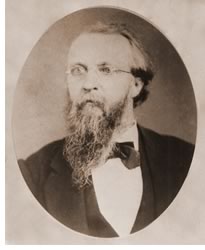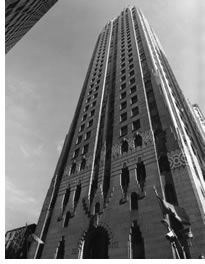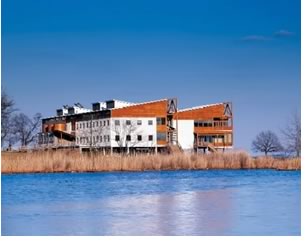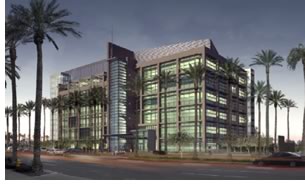

SmithGroup’s Manifest Destiny

In 1853, a self-taught architect from upstate New York named Sheldon Smith set out for the Northwest Territory in search of greater opportunities to practice his profession. That move would set the tone for the pioneering spirit that is the heritage of the firm now known as The SmithGroup, marking its 150th anniversary this year. Over its 15-decade history, the firm has grown and evolved, much in keeping with the profession as a whole, from a one-person office to an international and multidisciplinary practice.
 Settled
in Detroit, three generations of Smiths would carry on Sheldon’s
legacy, designing buildings that include Detroit’s Opera House,
Henry Ford’s Piquette Avenue Plant and his Meadowbrook Hall residence,
and two of the Motor City’s earliest skyscrapers, the Buhl and Guardian
buildings. Each succeeding generation—son Mortimer and grandson
Fred—made his own imprint, first on Detroit, then on the Midwest
and beyond. To this day, the firm’s pioneering spirit and leading-edge
business strategies serve as an industry model and reflect the coming
of age of the profession.
Settled
in Detroit, three generations of Smiths would carry on Sheldon’s
legacy, designing buildings that include Detroit’s Opera House,
Henry Ford’s Piquette Avenue Plant and his Meadowbrook Hall residence,
and two of the Motor City’s earliest skyscrapers, the Buhl and Guardian
buildings. Each succeeding generation—son Mortimer and grandson
Fred—made his own imprint, first on Detroit, then on the Midwest
and beyond. To this day, the firm’s pioneering spirit and leading-edge
business strategies serve as an industry model and reflect the coming
of age of the profession.
Foresight of multidisciplinary practice
At the turn of the century, as electricity, telephone service, more advanced
plumbing and ventilation systems, and steel frames became more prevalent
in commercial buildings, Smith, according to a firm history, began to
see the critical need to offer collaborative architectural and engineering
services. His firm soon became one of the country’s earliest multidisciplinary
practices as architect Fred Smith joined forces with engineer Ted Hinchman
and his partner Henry Field. In 1907, architect Maxwell Grylls replaced
Field, giving rise to the name that would stay with the firm for most
of the 20th century: Smith, Hinchman & Grylls. With the firm incorporated,
Fred Smith became its first president and served in that role until his
death 45 years later.
 During
this time, Fred Smith designed the Piquette Avenue plant, an early Ford
Motor Company factory, providing a link between small-scale manufacturing
and massive production volume later created at the Highland Park complex.
During the 1920s, the firm also designed the first of its Detroit skyscrapers,
the Romanesque and Gothic-styled, 26-story Buhl Building. In 1929, the
firm designed the Art-Deco Union Trust building, which featured an elaborate
tile, stone, and terra-cotta exterior and an ornate interior. Now called
the Guardian Building, the historic treasure has housed the SmithGroup’s
headquarters since 2000, when the firm renovated its 70,000-square-foot
space.
During
this time, Fred Smith designed the Piquette Avenue plant, an early Ford
Motor Company factory, providing a link between small-scale manufacturing
and massive production volume later created at the Highland Park complex.
During the 1920s, the firm also designed the first of its Detroit skyscrapers,
the Romanesque and Gothic-styled, 26-story Buhl Building. In 1929, the
firm designed the Art-Deco Union Trust building, which featured an elaborate
tile, stone, and terra-cotta exterior and an ornate interior. Now called
the Guardian Building, the historic treasure has housed the SmithGroup’s
headquarters since 2000, when the firm renovated its 70,000-square-foot
space.
The Great Depression saw the firm relying even more on its engineering studies, consulting, and technical expertise. Government commissions allowed the firm to survive, but at the same time the staff shrunk from 250 employees to just six. The repeal of the 18th Amendment in 1933 brought a much-needed commission in the form of a newly re-legalized Illinois distillery. University and automotive work in the 1930s and 1940s allowed the firm to rebuild its size and strength, and, in 1948, three years after Minoru Yamasaki joined SH&G as director of design, the firm teamed with Eero Saarinen to design the landmark General Motors Technical Center in Warren, Mich. In the second half of the 20th century, Smith, Hinchman & Grylls expanded the range of services they offered, particularly in construction management and environmental research, merging with other firms to bolster their position in these areas.
 Through
the 1970s and into the 1990s, the firm also concentrated many of its design
and technical efforts on sustainable design, recently receiving the first
U.S. Green Building Council Leadership in Environmental Engineering Design
(LEED™) Platinum rating for the Philip
Merrill Environmental Center, the headquarters building for the Chesapeake
Bay Foundation, an environmental advocacy and education organization.
Through
the 1970s and into the 1990s, the firm also concentrated many of its design
and technical efforts on sustainable design, recently receiving the first
U.S. Green Building Council Leadership in Environmental Engineering Design
(LEED™) Platinum rating for the Philip
Merrill Environmental Center, the headquarters building for the Chesapeake
Bay Foundation, an environmental advocacy and education organization.
SmithGroup President and Chief Executive Officer Carl Roehling, FAIA, says the firm nurtures both its technical savvy and design excellence, which, he says, is a constant dichotomy for the firm. The SmithGroup is “not willing to give up one for the other,” he says.
Rediscovering core services
Having delivered services from development, project management, and specialized
consulting, the firm is now returning to focus on its core services: architecture,
engineering, and planning, Roehling says.
“With the narrowing of services to architecture, engineering, and planning,” adds SmithGroup Chairman David King, FAIA, “we are creating value with creativity. We’re delivering the highest-quality design services to our clients and, at the same time giving them the best people-to-people relationships the industry has to offer. These are no doubt our stand-out attributes, as we reach this huge milestone in our history.”
The decision to redefine the firm’s core comes after some introspection after years of exponential growth and a series of mergers that led to expansion in terms of personnel, geography, markets served, and services offered. For the SmithGroup, it was a question of whether the leadership was passionate about pursuing these markets, and what is best for the firm. Roehling says the choice was easy. With SmithGroup’s core services already so broad, “we didn’t want to offer these specialized services if we couldn’t be the best in these markets . . . Every firm has to look at its own culture,” he says.
In making the transition, the firm reorganized in 2002, with King as chairman and Roehling as president and CEO. The firm also created more than 40 studios organized around smaller multidisciplinary technical teams, each of which operates like a small firm. The result, Roehling says, is a practice that more specifically focuses on client needs and better and faster design. King, the firm’s principal designer, spends much of his time in the firm’s eight nationwide offices participating in charrettes with the studios. The arrangement also prizes diversity of expertise and opinion, two of the firm’s long-lasting values.
New projects, new challenges
SmithGroup is now spending more of its time and resources than ever before
in market research and looking ahead five and more years, Roehling says.
With these efforts come annual strategic-planning meetings, scenario planning,
and looking where the industry and other markets are going. “It’s
really not so important that we’re 150 years old. What’s truly
important to our clients is that we’ve adapted a culture of sustainable
design within our firm; we’re long-term thinkers,” King told
Architecture Week earlier this
month.
The firm, with 900 employees and $135 million in revenue, is also taking the time to make sure its own practices are on track with a research and solutions group that cuts across studios and offices to take a more global look at the firm’s projects and the work of each design studio. Its “Lab 2020” project, a creation of the Research Solutions Group, investigates emerging science and technology and gives the firm insight on market trends and their impact on business-environment technologies.
People at the firm also invest their time in their profession: Eugene Hopkins, FAIA, a SmithGroup senior vice president, will serve as the national AIA president in 2004. Roehling has served on the national AIA Board and continues to be involved at the local and state levels. And King serves on the national AIA component Committee on the Environment and previously the Committee on Design.
 A
future steeped in knowledge
A
future steeped in knowledge
The research market makes up nearly one-third of the firm’s current
workload, with heavy concentrations also in the health-care and university/learning
sectors. Other leading practice areas include office/workplace, museum/cultural
facilities, historic preservation, and waterfront planning. This is a
different composition of markets than even 10 years ago, when a third
of the firm’s projects were industrial–common for a Detroit-headquartered
firm. The firm does continue to work with the automotive industry, although
now its primarily for office/research facilities, such as the new, 1-million-square-foot
headquarters “village” for auto supplier giant Visteon Corporation,
now under construction in suburban Detroit.
The firm continues to draw critical acclaim for its projects, including the McNamara Terminal/Northwest Gateway at the Detroit airport and the new Discovery Communications worldwide headquarters in Silver Spring, Md. On the boards is the California Pacific Medical Center, a reorganization of the health-care providers multi-campus delivery system in San Francisco, and the IGC/TGen Headquarters, which, when completed in 2004, will become the first bioscience research facility in Phoenix. SmithGroup is also designing the U.S. Department of Energy’s National Renewable Energy Laboratory in Golden, Colo. At a minimum, the firm expects the NREL project to meet Silver LEED™ certification.
And with that, happy birthday, SmithGroup!
Copyright 2003 The American Institute of Architects.
All rights reserved. Home Page ![]()
 |
||
| Photos courtesy of SmithGroup. Sheldon Smith, the patriarch of the family of architects that would make an indelible imprint on Detroit, the Midwest, and beyond. Now called the Guardian Building, the Art Deco Union Trust building, designed by Sheldon’s grandson Fred, has housed SmithGroup’s Detroit headquarters since 2000, when the firm meticulously renovated the 70,000-square-feet it now occupies. The Philip Merrill Environmental Center, Annapolis, Md., has been called the “greenest office in America.” The headquarters for the Chesapeake Bay Foundation, an environmental advocacy and education organization, was the first to be tapped for the top Platinum rating for Leadership in Environmental Engineering and Design (LEED) from the U.S. Green Building Council. The building was named one of the Top Ten Green Projects of 2001 by the U.S. Department of Energy and AIA’s Committee on the Environment. It melds the firm’s attention to engineering and design excellence. As part of the design-build team with DPR Construction, SmithGroup is the designer of the headquarters for the International Genomics Consortium/Translational Genomics Research Institute (IGC/TGEN), Phoenix. When completed in 2004, the headquarters promises to be a bioscience research center of international stature. Inside, a consortium of renowned researchers will conduct biomedical research to target the development of new treatments and cures for cancer, diabetes, and other diseases. Many of the firm’s current projects and work on the boards are in the health-care sector.
|
||